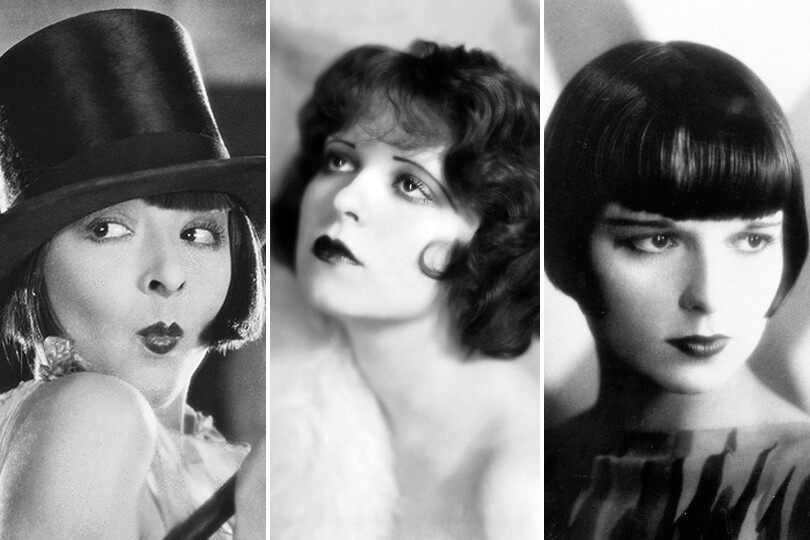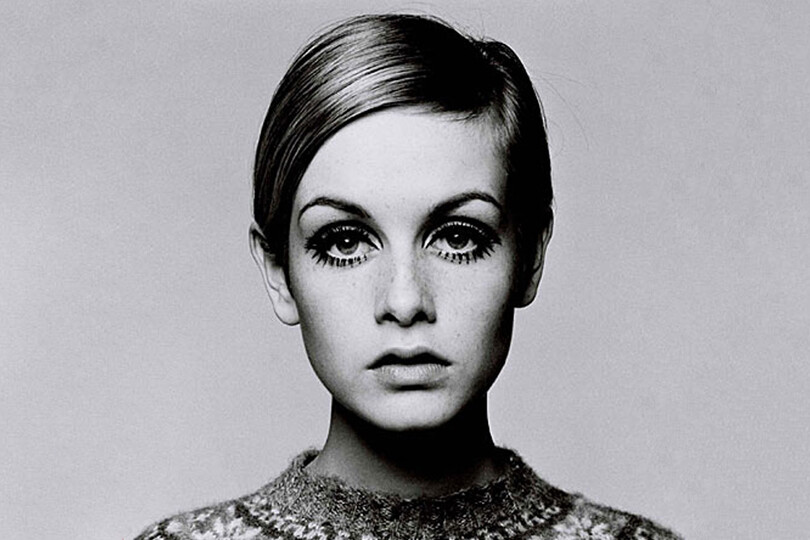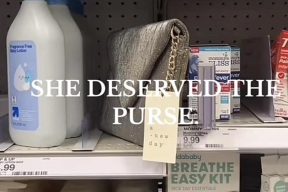Part of an ongoing series of 29Secrets stories, taking a deep dive into the history of legendary beauty products and iconic fashion and pop culture moments…
By Christopher Turner
Illustration by Michael Hak
Eyeliner wields a power that other makeup products just don’t have: the ability to completely change the look of an entire face with just a swipe. Its true, super-sharp liquid pens and luxuriously smooth pencils have the ability to define, accent and highlight the appearance of the eyes, and ultimately the entire face, in just a few strokes. Eyeliner is also a beauty product that instantly defines eras and icons…think Cleopatra, Twiggy, Grace Jones, Boy George, Amy Winehouse.
You might think that eyeliner was always part of a classic beauty routine, but the everyday use of eyeliner in Western cultures did not begin until the early 1900s – in fact, most women had never even heard of it before then. Everyday use of eyeliner didn’t really catch on until after 1912, when archaeologists discovered the bust of the ancient Egyptian Queen Nefertiti in Egypt. This discovery, and the discoveries of other ancient Egyptian artifacts, helped introduce the Western world to ancient Egyptian eyeliner styles, which quickly became fashionable and ultimately became pretty standard on faces of women (and men) around the world.
Let’s take a trip back to ancient Egypt and beyond for a brief history of eyeliner, to find out how it ended up in the makeup bags of every cosmetics wearer you know.
Ancient Egypt, Mesopotamia, Japan and beyond
As early as 10,000 BC, Egyptians and Mesopotamians made use of various cosmetic products, primarily for aesthetic reasons. The first recorded eyeliner-like substance known to historians is kohl, which was used by the people of ancient Egypt to trace their eyes and was applied with a thin stick or needle. Kohl is a mixture of galena (a form of lead sulfide) and other minerals mixed with water, oil or other soluble substances, like animal fat. Poorer Egyptians had to replace lead and other minerals with fire soot, meaning that the quality of one’s kohl (detectable by its shine and wear) could be used as a measure of class. Though its formulas have differed slightly based on time, location and the wealth of its wearers, the function of kohl remained the same: to decorate the eyes, brows, and occasionally other facial features.
Appearances were also crucial to Egyptian identity in death. Burial sites uncovered from the very beginning of that society’s history, in pre-dynastic times, show that it was common for Egyptians to include everyday items like combs, scented ointments, jewellery and cosmetics in the graves of men, women and children (many graves have been found with makeup, including jars of kohl, still inside them).
According to Madeleine Marsh, author of Compacts and Cosmetics: Beauty from Victorian Times to the Present Day, the ancient Egyptians “lived and died surrounded by kohl jars, makeup boxes [and] perfume vials” in order to remain eternally beautiful in the afterlife.
While kohl outlined and complimented their eyes, beautification wasn’t the only reason it was applied in ancient Egypt. Historians believe that wearing kohl was also a way to honour deities as well as help reduce the sun’s glare (the oils and animal fats used to make kohl easier to apply also protected their skin from the scorching sun). Newer research theorizes that ancient eye makeup worn by both sexes and all social classes may also have been worn to help prevent eye infections, which were especially problematic in marshy environments such as the Nile area. In 2010, scientists discovered kohl’s antibacterial properties and reported that substances found in samples of ancient Egyptian eyeliner held in 52 different containers in the Louvre museum in Paris actually did help the immune system of these early beauty pioneers by helping to prevent and fight bacterial infections.
Of course, the use of kohl wasn’t exclusive to ancient Egypt. Along with other cosmetics and exotic goods, it was exported from Egypt and sold across the Mediterranean. Historians have found evidence of the use of kohl and other eyeliner-like substances used to magnify the eye by, among others, the ancient Romans (who called it platyophthalmon, a term that came from a passage in Pliny the Elder’s Natural History book XXXIII.10), the Canaanites in the Levant, the ancient Greeks, and more.
According to author Kelly Olson in her article, “Cosmetics in Roman Antiquity: Substance, Remedy, Poison,” Roman women used to line their lids and cosmetically dye their lashes daily. Similar to the ancient Egyptians, eyes were lined with kohl, a mixture of ashes and oil, or saffron, and applied with either a thin stick or needle.
Eyeliner was popular not just around the Mediterranean but around the world in ancient times. In Japan, for example, kohl was the beauty enhancer of choice. As early as 3000 BC in Japan and China, men and women used cosmetics to define their eyes and define their status. Elsewhere in Japan, the geisha tradition gained distinction in the mid-18th century, and young maikos (the apprentice geishas of western Japan) were required to wear their makeup, including charcoal to outline the eyes, nearly daily for the first three years of practice.
In North America, the Pawnee and Osage people often used paint around their eyes and on their face before they engaged in battle with an enemy. At other times, face paint was not connected with war preparation, and paint designs were worn around the eyes to designate membership in societies, as marks of achievement or for spiritual reasons like participating in ceremonies or mourning for the dead. The oldest materials used to paint around the eyes and on the face were derived from animal, vegetable and mineral sources, with earth or mineral paint being the most common.
Early attitudes towards eyeliner shifted as the years went on. By the Victorian age, the obvious use of makeup, including eyeliner, was considered socially indecent, especially in the Western world. English royal opinion ultimately influenced how women at the time viewed beauty, and Queen Victoria herself didn’t wear makeup, viewing the practice as “vulgar.” Those who did wear makeup in the Victorian era were likely to take a more covert approach, to avoid being mistaken for a “painted lady” (a term used to refer to actresses and prostitutes at the time).
“In the 19th century, you did [makeup] very discreetly. You might darken your eyelashes with elderberry plants or a bit of kohl, but you did it in secret, and you did it yourself,” says Marsh.
The widespread fascination with a sculpture
By the early 1900s, eyeliner was poised to make a big comeback, thanks to a discovery that immediately prompted a fascination with ancient Egyptian culture and ultimately saw attitudes towards fashion and makeup, especially eyeliner, change dramatically.
In 1912, German Egyptologist Ludwig Borchardt led a team that discovered the bust of ancient Egyptian Queen Nefertiti in Amarna, Egypt. The bust of the legendary royal, which is now on permanent display in Berlin’s Neues Museum, had thick black lines of kohl outlining her almond-shaped eyes.

This discovery was followed by other examples of ancient Egyptian art, each also depicting women and men with heavily lined eyes. That led to a flurry of interest around ancient Egyptian culture and style, and their use of eyeliner, that spread across the Western world, inspired by the perceived seductiveness of two of Egypt’s most famous queens: Nefertiti and Cleopatra.
Simultaneously, Hollywood began to expand its reach with the opening of more and more movie theatres to show the new innovation of silent movies. By the 1920s, starlets like Colleen Moore (1899-1988), Clara Bow (1905-1965) and Louise Brooks (1906-1985) helped inspire an aesthetic change for generations of young women to come. On the big screen, these silent movie actresses wore heavy smoky eyes along with red lipstick drawn with precise lines to accentuate their facial features and expressions, which were otherwise difficult to make out in the black and white films of the time.

Actors also wore eyeliner, if more subtly, for this effect. Most notable was Charlie Chaplin in his famous 1914 character The Tramp, though he mostly wore eye makeup to achieve a purposely funny, cartoon-like look.
The 1920s were indeed a time of experimentation for women, and they applied their eyeliner with a sense of drama to emulate the Hollywood actresses and flappers who had already broken away from the Victorian pre-World War I female model. Cosmetics brands like Maybelline, Revlon and Max Factor jumped on the heavy black eyeliner trend, producing kohl eyeliners (much safer than ancient Egyptian formulas) and shadows that generated huge profits. Women also made their own DIY versions of the product with petroleum jelly and soot.
By the 1930s, heavy black eye makeup was replaced with softer lines and shimmery shadows in feminine pinks. Mascara, commonly used to enhance the eyelashes, had become a makeup essential by this time, as had faint, pencil-thin eyebrows. Eyeliner was still worn, although usually it was worn only on the upper lid, traced right against the lash line from the inner to the outer corner, ending in a slightly upturned flick.
“By the time you get to the late ’30s – we’re really talking a 10- to 15-year period – if you didn’t have your makeup on, you weren’t considering yourself properly as a woman; your husband would leave you; you didn’t have respect for yourself,” says Marsh. According to her, eyeliner’s popularity was based in burgeoning social liberties, as well as in domestic norms. “After WWI, there was a revolution: women began to get the vote, it’s when they shed skirts [for pants] and started drinking and smoking in public. There were a whole load of new freedoms – among those new freedoms are cosmetics,” she says.
Eyeliner began to fade into the background by the 1940s. If worn at all, it was nothing dramatic: the go-to eyeliner style involved a thin line applied right against the upper lash line. In contrast, sleek cat’s-eye looks gained popularity in the 1950s, with beauty icons like Marilyn Monroe and Elizabeth Taylor sporting the elegant winged eye effect.
An explosion of creativity
In the 1960s, stars like Brigitte Bardot and Jean Shrimpton took the cat’s-eye look a step further by wearing heavy winged liner and lots of mascara. By the mid-’60s eyeliner styles got experimental, thanks in part to Mod fashion and fashion designers like London-based Mary Quant, who encouraged women to be more playful and experimental with their eyeliner looks. As Mod and youth fashion movements spread across the globe, It-girl and Andy Warhol muse Edie Sedgwick popularized wearing copious amounts of eyeliner, while British model Lesley Lawson (better known as Twiggy) rose to fame thanks to her doe eyes and use of heavy eyeliner along the lash line and eyelid crease. Twiggy would even draw on an extra layer of lashes underneath her eyes with eyeliner to give her look more drama and add the appearance of more volume and length. It’s safe to say that in doing that, an eyeliner icon was born.

From the 1970s onwards, eyeliner looks continued to evolve at a rapid pace. In the 1970s, primarily inspired by the rise of disco and punk rock, heavy black eyeliner looks were popular, but it wasn’t just women wearing it. Rock gods like David Bowie, Mick Jagger and Steven Tyler all emphasized their eyes with swipes of eyeliner for a slightly effervescent cat’s eye that was perfect for the stage.
Eyeliner went techno colour in the 1980s, paired with lots of coloured eyeshadow, thanks to the influence of pop singers like Madonna, Cyndi Lauper, Whitney Houston and Boy George.

The neon-bright eyeliner trend was temporary, though: by the 1990s, black eyeliner and dark eyeliner colours like deep rouges and purples came back into vogue. Heavy, smudged eyeliner was heavily influenced by grunge styles and artists like Courtney Love, while ’90s girls less fond of the grunge look still wore eyeliner, but kept it to a simple line. Dark eyeliner trends continued on into the 2000s, but eyeliner was worn on the waterline to give the illusion of thicker lashes.
The creation of YouTube in 2005 meant massive changes for the beauty industry. Early beauty vloggers like Michelle Phan (who began posting makeup tutorials in 2007) quickly established beauty empires while teaching audiences how to properly apply eyeliner. As an example, Phan’s first eyeliner tutorial has amassed over 7.6 million views since it was posted on October 25, 2007.
While countless male celebrities through the ages had worn eyeliner, the mid-2000s introduced the term “guyliner.” Billie Joe Armstrong, Jared Leto, Pete Wentz and The Killers’ frontman Brandon Flowers all helped bring the guyliner trend to the MTV-watching mainstream. Wentz was so dedicated to the cause that he even posted a video how-to for his kohl-lined lash lines.
Today, eyeliner of varying degrees of thickness is sported in a number of different ways – colourful, graphic, smudgy – and can take you from high glam to effortless beauty depending on the technique. The history of eyeliner proves that it is more than just a simple, frivolous beauty product. It’s a fascinating cultural symbol that has been worn by everyone from Egyptian goddesses to prostitutes to everyday women and men around the world to help express their own identity expression, personality and style.
![]()
Want more? You can read other stories from our The Story Of series right here.











